This post may contain affiliate links. For more information, see our privacy policy.
A rich, brothy chili-tomato stew with tender pork shoulder, hominy corn, and roasted red peppers, this Braised Pork Shoulder Pozole, served with an assortment of garnishes, is always a huge hit!
If you like a make-ahead dish that's fun, super delicious, can feed a crowd and freezes well, this Braised Pork Shoulder Poszole is for YOU!
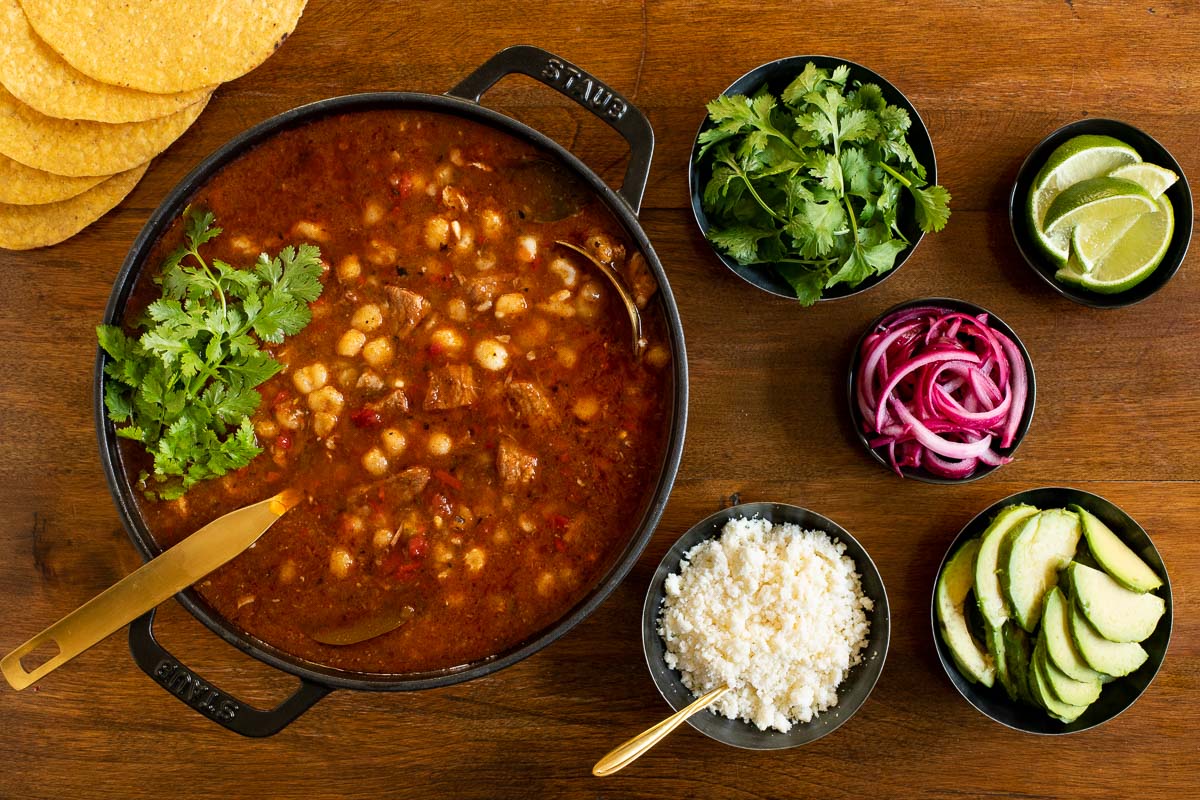
Food and Wine suggests serving a small bowl of dried oregano along with the other garnishes. They say, "for each serving, place a pinch of oregano between palms; rub over and into the soup to release its aroma." See what I mean? The sky truly is the limit here and the garnishes can be tailored to everyone's own preferences!
Although there's a bit of prep work for this Braised Pork Shoulder Pozole, almost all of the hands-on effort is done up front and the oven works the delicious magic as the pork, tomatoes, roasted red peppers, spices, herbs and hominy have a chance to marry and meld.
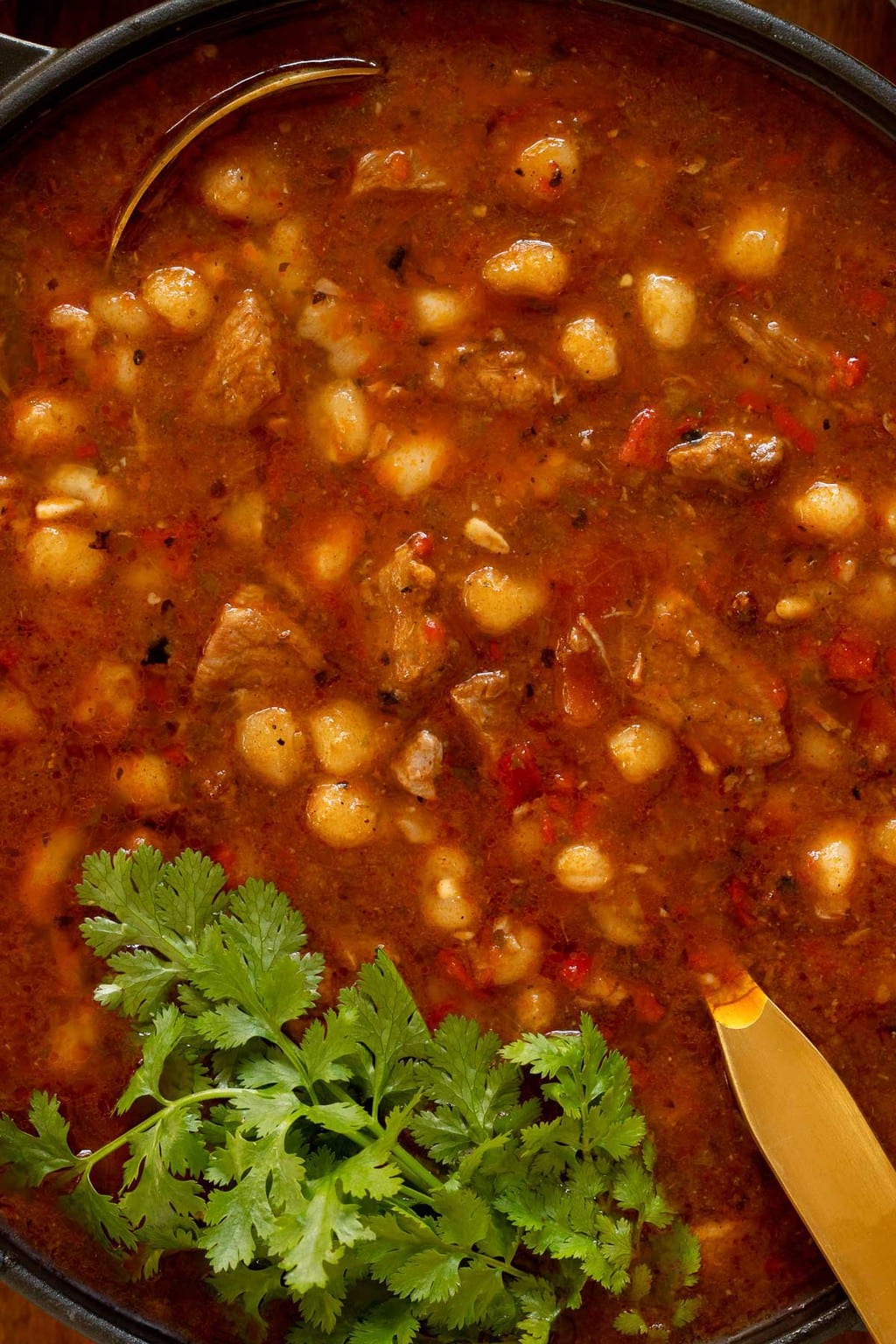
What's hominy?
If you've never lived in the southern United States, you might not be familiar with hominy. Scott and I grew up in Wisconsin and didn't have a clue what hominy was until we moved to North Carolina forty years ago. For us, it fell into the same "foreign foods"category as grits, butter beans, collards, cracklings, chitlins, hoppin' John and moon pies... we didn't have a clue and had lots to learn after we moved south.
Hominy, according to Bon Appetit, "is maize (corn) that's been dried, then soaked in an alkaline solution to remove the hull and germ. This treatment not only improves the nutritional content of the corn, but also gives it a more complex flavor and aroma". It's sold dried or cooked (usually in cans). A kernel of canned hominy is about triple the size of a raw sweet-corn kernel.
Hominy is also ground into masa for grits, tortillas and tortilla chips and is what gives tortillas that distinctive nutty-sweet corn flavor.
Although there are probably a zillion renditions of pozole, from red (tomato-chili-based) to green (tomatillo-chili-based) and including beef, pork, or chicken, the signature ingredient in pozole is hominy. Hominy adds a distinctively delicious flavor to pozole that you don't want to miss. This Braised Pork Shoulder Pozole actually calls for two 29-ounce (or four 15-ounce) cans of hominy which is quite a bit, but half of it seems to "melt" into the delicious braising broth. The second can is added later for texture and additional flavor.
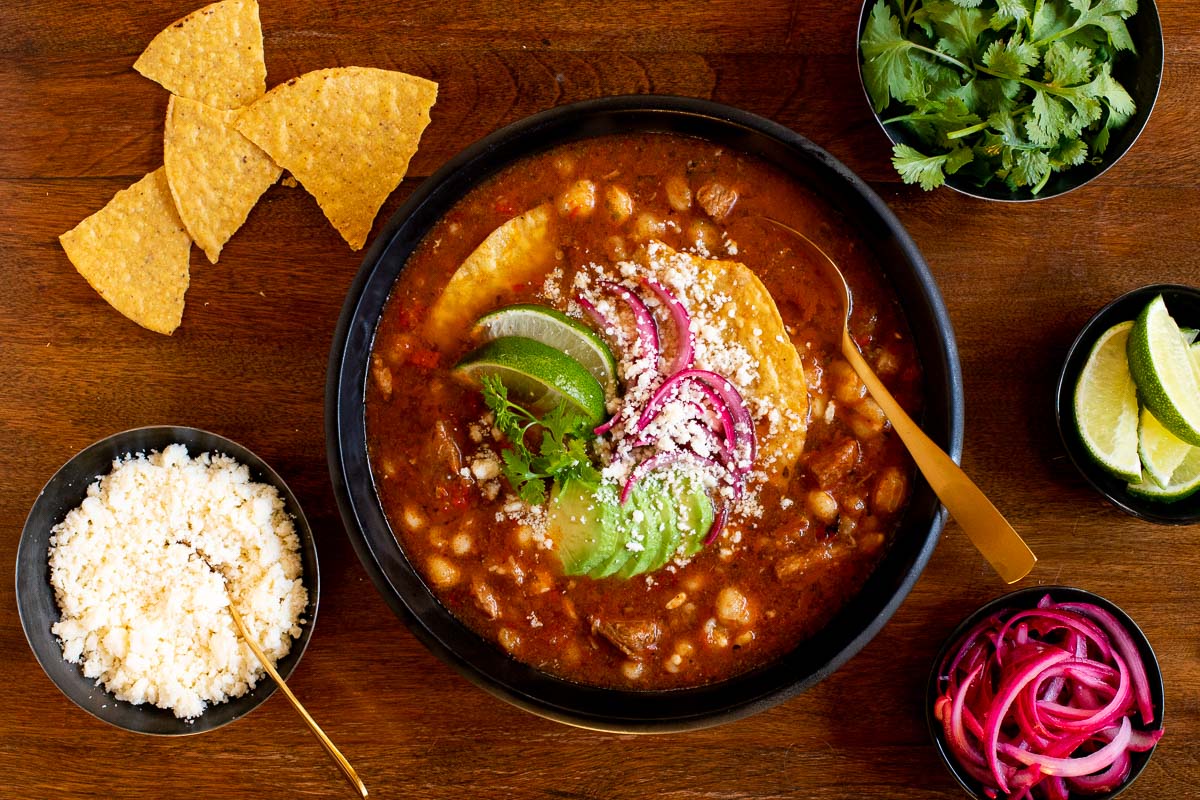
Where do you buy hominy?
Hominy can be purchased at most larger grocery stores these days. It's usually found in the canned vegetable area but if you can't find it there, check the canned beans aisle next. If it's not in either of those places look in the international aisle in the Mexican/Latin American section. Last resort? It is readily available at Mexican grocers as well as online.
Hominy comes in both white and yellow varieties. Both are similar in flavor although the yellow is known to be slightly sweeter. I usually use the white for this Braised Pork Shoulder Pozole as I like the way it looks, but either will work.
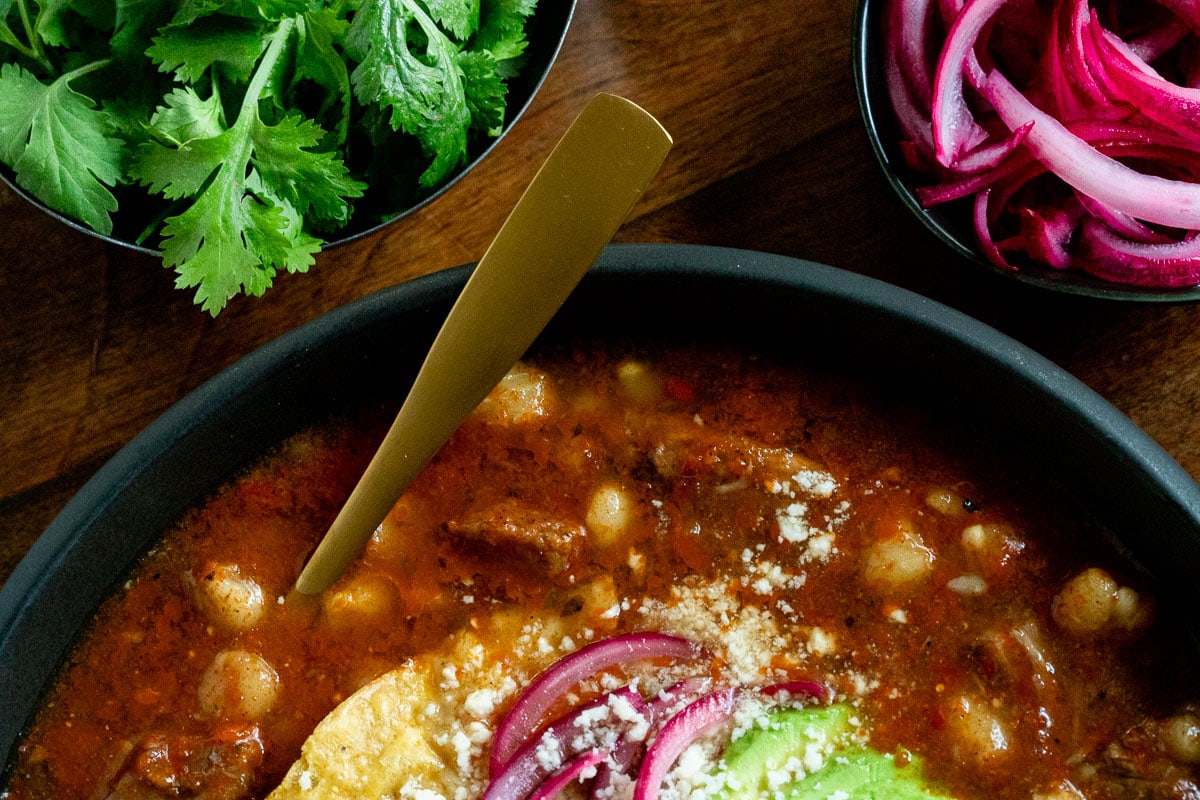
What kind of pork to purchase for this Braised Pork Shoulder Pozole?
You want a use pork shoulder or Boston butt for this recipe. These are both relatively tough and fatty cuts of pork that become melt-in-your-mouth tender when slowly braised. Although pork loin and pork tenderloin are also delicious cuts of meat, they don't work well when cooked for long periods of time as in this pozole recipe.
You'll need around 4 pounds of boneless pork shoulder or butt for this recipe although when you trim off the excess fat, the weight will be closer to three pounds. You can also purchase pork country-style ribs which are usually pork shoulder, but check with the butcher or meat department worker before purchasing these ribs. Some stores use pork loin for country style ribs which is too lean and won't result in tender meat.
An easier version
One last note. Traditional red pozole (pozole Rojo) is made from dried chili peppers, either ancho chilis or guajillo chiles, or both. These chilis are rehydrated and then pureed before adding to the pork and other pozole ingredients. I chose an easier (but just as tasty) approach. I use Ancho chili powder, sweet paprika and smoked paprika for lots of rich flavor without the extra work. You can call me lazy, but I'm all for simplicity if the results are still delicious!
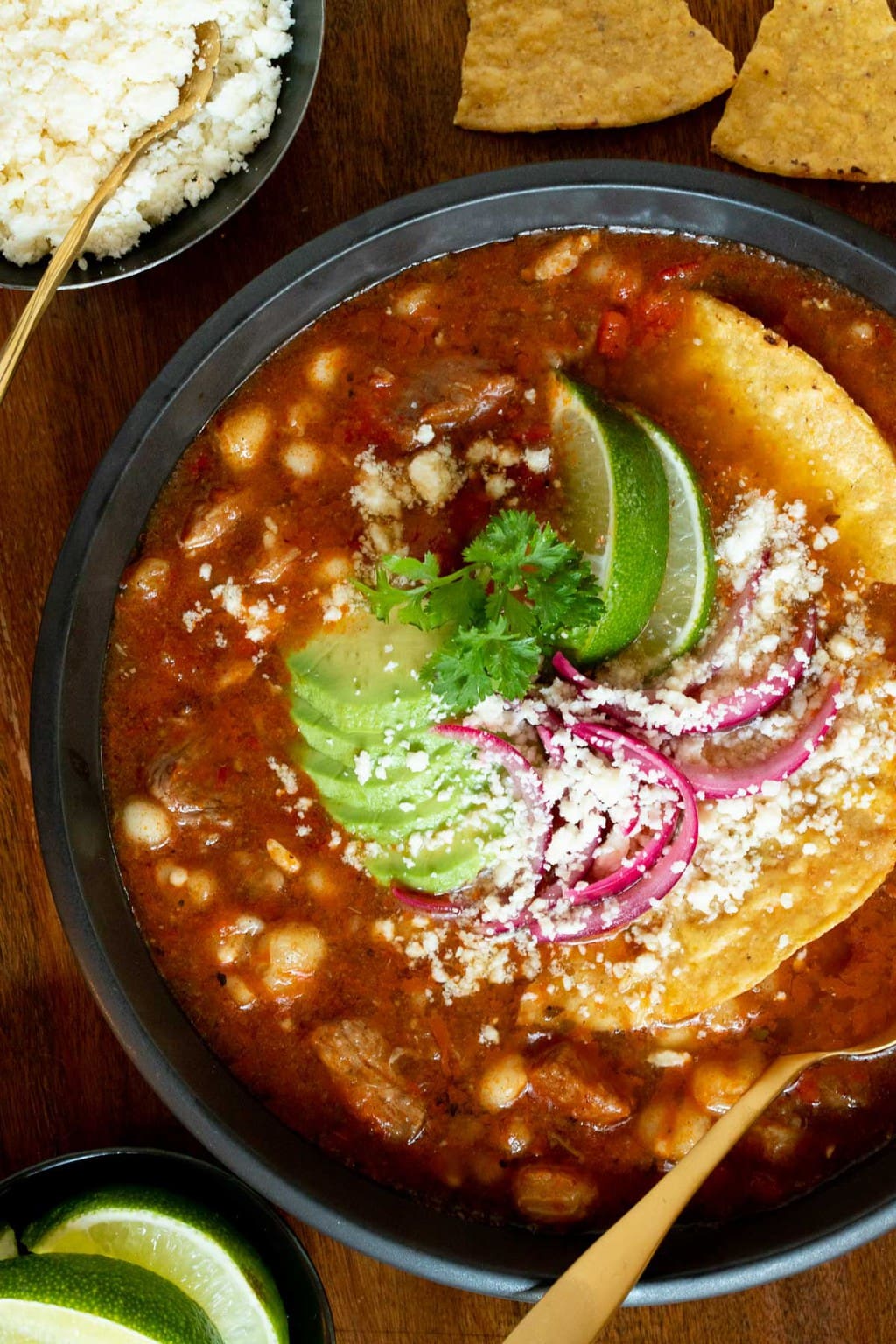
I'm going to warm up a bowl of this Braised Pork Shoulder Pozole right now for lunch and can hardly wait. It's so nice to have a container of this delicious stew/soup stashed in the fridge for quick meals on the run as well as work and school lunches. Put this recipe on the menu soon, you'll feel like you've taken a delicious trip to Mexico without ever having to leave the comfort of home. Hola!
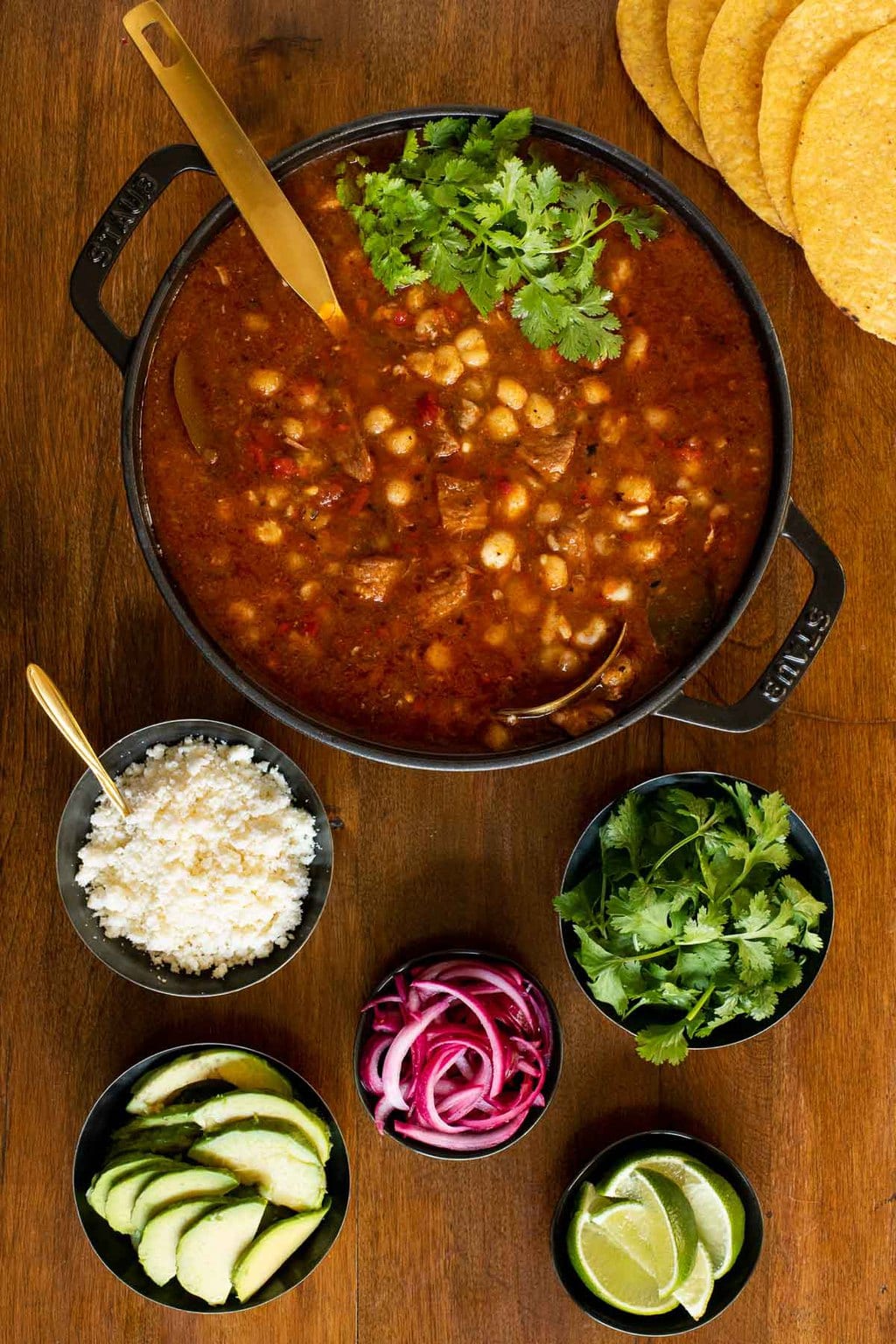
Café Tips for making this Braised Pork Shoulder Pozole
- Check out the section above regarding which cuts of pork work best for this pozole. If you can find boneless pork that's great. If you have to buy a bone-in cut, it's fine. Just allow a little extra to compensate for the bones.
- Part of the prep for this Braised Pork Shoulder Pozole is searing the pork before it braises in the oven. This helps develop great flavor and deep rich color. When searing, be sure the oil is nice and hot. You want to heat the oil until it's almost to the point of smoking. If the oil isn't hot, the pork will cook and release its juice instead of searing the juice in. When searing, make sure the pot is centered on the flame or heat source.
- I like to use white hominy for this recipe but yellow will also work.
- This recipe calls for ancho chili powder which is made from ground poblano chilis. It's delicious, imparting mild heat along with a bit of sweet and smokey flavor. Ancho chili powder is available at most larger grocery stores and online.
- This recipe also calls for smoked paprika. You can find smoked paprika in the spice section of most larger grocery stores and online. Look for a container that does not say "hot" smoked paprika or you will be adding a lot of extra heat to the posole. Trader Joe's has delicious smoked paprika as does Whole Foods (365 brand).
- Although ancho chili powder is not super hot, it's always better to start with less and add more later to taste. I recommend starting with 2 teaspoons then tasting the pozole after it's been in the oven for a while and adding more if desired. You can always add heat, but trust me, you can't take it out!
- Although you can definitely use tortillas chips as a condiment/garnish for this Braised Pork Shoulder Pozole, I like to purchase the large round crispy tostadas instead. I think they have a more authentic flavor and are a little more unique. They come in a large package and are reasonably priced. You can find these crisp tostadas in the international area of most groceries in the Mexican/Latin American section or online.
- This recipe calls for ½ cup chopped cilantro. If you're not a cilantro fan, don't skip this ingredient. As it cooks the cilantro imparts great flavor but in the end, won't taste like cilantro. I promise that cilantro haters will NOT know it's in here. You can use the stems (they have great flavor) and save the leaves for garnish.
- You will find pozole spelled with an "s" and with a "z'. Both are correct. Posole is the English spelling whereas pozole is Spanish.
Thought for the day:
Truly my soul finds rest in God;
my salvation comes from Him.
Psalm 62:1
What we're listening to for inspiration:
If you enjoyed this recipe, please come back and leave a star rating and review! It’s so helpful to other readers to hear other’s results and ideas for variations.

- 1 tablespoon mild paprika
- 1 tablespoon mild smoked paprika
- 1 tablespoon dry oregano
- 1 tablespoon brown sugar
- 2-4 teaspoons ancho chili powder start with 2 and add more later, to taste
- 2 teaspoons garlic salt
- 2 teaspoons ground cumin
- 2 teaspoons ground coriander
- ½ teaspoon black pepper
- 4 pounds pork shoulder or country shoulder ribs trimmed of excess fat and cut into 1-inch pieces
- 1 tablespoon extra virgin olive oil more if needed
- 1 large sweet or yellow onion finely chopped
- 6 medium garlic cloves finely minced
- 6 cups beef broth
- 2 14.5-ounce cans fire-roasted canned tomatoes
- 10-12 ounces roasted red peppers drained and finely chopped
- 1 tablespoon Worcestershire sauce
- 4 ounces mild green chilis (canned) undrained
- 3 large bay leaves
- ½ cup chopped cilantro
- 2 29-ounce cans white hominy (or 4 15-ounce cans) drained and rinsed
-
Preheat the oven to 275˚F. Cut the pork into 1-inch pieces, trimming off any large areas of fat.
-
For the rub:
-
Combine all of the rub ingredients in a small bowl. Stir to combine.
-
Place pork in a large bowl or ziplock bag (I use a 2 gallon). Sprinkle with the rub mixture and stir to coat. If using a ziplock bag, seal the bag and shake vigorously to coat the pork.
-
Heat a large Dutch oven or soup pot to medium-high. Add the oil and swirl the pan a bit until nice and hot. Add half of the pork and spread to a single layer. Cook undisturbed for 3 minutes or until meat is golden brown underneath. Flip the pork with a metal spatula, keeping the heat high enough so that the meat continues to sear. Cook for another 3 minutes then remove the pork to a clean plate. Repeat with the second half of the pork, adding a bit more oil to the pan if it seems dry.
-
Add the first half of the pork back into the pan. Reduce the heat to medium-low and add the onion. Stir well and cook for 3-4 minutes, scraping up the brown stuff (fond) that has formed on the bottom of the pan as the onions begin to release their juices. When the onions are soft and translucent, push the pork to the sides and add the garlic. Stir the garlic in the center of the pot for 30 seconds.
-
Add the broth, reserved pork (and any juices that have accumulated on the plate), fire-roasted tomatoes, roasted red peppers, Worcestershire sauce, green chilis, bay leaves, oregano, cilantro and 1 can of the hominy, undrained.
-
Bring the mixture to a boil then cover the pot tightly and place in the preheated oven for 2 hours.
-
Uncover and add the second can of hominy (drained). Taste and add more ancho chili powder, if desired. Increase the oven temperature to 350 return to the oven, uncovered for 1 hour, stirring halfway through.
-
Taste and add salt if needed. Serve with any of the garnishes described above in the post.
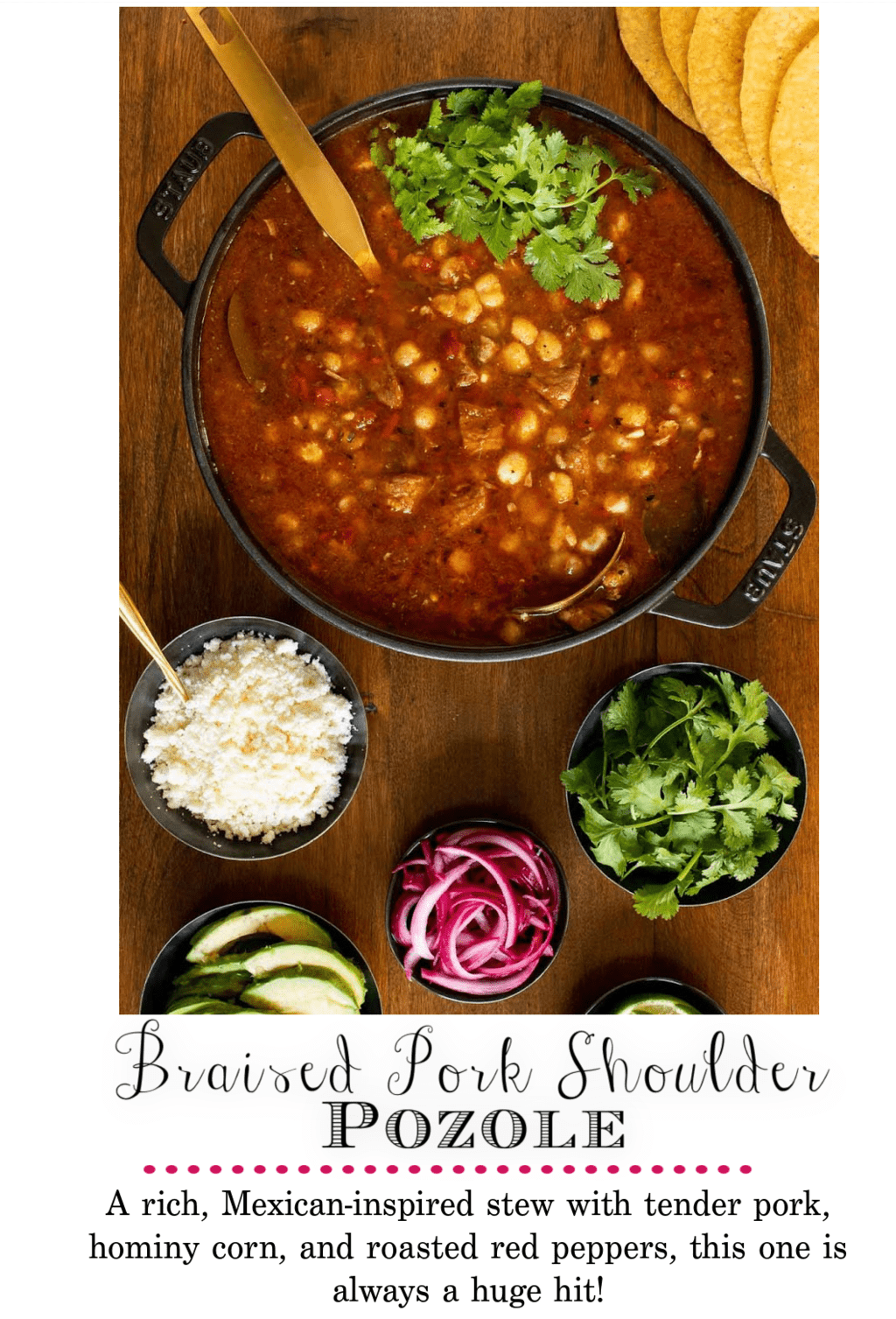

NAUmom says
Step 2....should it say with the second half of the pork in the pan? Havenn't we already taken out the first part of seared pork?
Next question, is the only drained add in the roasted red pepper? Do I add the hominy and green chiles without ddraining?
Thanks
Chris Scheuer says
Sorry for the confusion. I have corrected that errors in the instructions. You do drain the hominy but not the green chilis
Maryann says
I am wondering if anyone has tried this recipe in a slow cooker? If you have, for how long and on low or high setting.
Nanci says
I would like to try making this but the recipe says it serves 16. Have you ever halved it?
Chris Scheuer says
Yes, you can do that, Nanci.
Lara says
Is there something wrong with Step 2 of the recipe? It mentions pushing beef to the side and then adding garlic. I do not see beef in the ingredients and thought this was a pork recipe so just wondering if this is an error.
Chris Scheuer says
You're much more observant than I am, Lara! Thanks so much for noticing that and letting me know. I have corrected the recipe, it should have said "pork".
Letty says
I will make this tmr, it looks delicious. Thanks for the recipe.
Chris Scheuer says
You're welcome, Letty, enjoy!
Elsa says
I actually started making this today, and later saw this recipe..I used chicken breasts that I poached
Chris Scheuer says
That sounds wonderful too!
Jinger says
Have you slow simmered this recipe on the stovetop instead of the using the oven? Ould timing be about the same or longer?
Chris Scheuer says
Hi Jinger, I haven't tried it on the stovetop but it should work fine. I would simmer it for two hours with the cover on and then uncover until nice and tender.
Jinger says
Chris,
I made this on the stove top and it came out beautifully. Simmered with lid in for 2 hours then without lid for another hour. The flavors are robust!
Marianne A. says
Have you ever tried this in an instant pot? Our kitchen is undergoing renovation and I’ve been cooking solely in an instant pot! This looks delicious and I would love to try it.
Chris Scheuer says
Hi Marianne, I haven't tried this in an instant pot but I think you definitely could.
Larry says
Seems like an OK recipe, there are some changes I would make but that's a personal thing. I would add some dried chili pequin, it adds a back note of zip. Oh, just to point out, pork butt and shoulder are the same cut of meat. The reason they refer to them as butts is that in the day they were stored in containers called butts for preservation.
Chris Scheuer says
Thanks, Larry, for sharing your opinion and adaptations.
You're partially correct about the pork butt and pork shoulder. They both come from the shoulder of the pig but from different parts of the shoulder. From the experts at Cook's Illustrated: "pork butt is higher on the foreleg, while pork shoulder is farther down."
Also, the shoulder typically has less fat and marbling.
I've used both cuts for this recipe with good success!
Please leave a star rating after you've tried a recipe to be helpful to other cooks, thanks!
Mr Larry Hamilton says
Chris, I'm not sure what/where Cooks Illustrated "experts" are referring to but after being raised on a hog farm and being in the meat industry for over 30 years and butchering many thousands of hogs, well we will agree to disagree. I did make the Pisole as directed with the exception of the added chili pequine, like the added heat, and it turned out quite nice. Thanks for all the wonderful recipes.
Chris Scheuer says
Thanks, Larry for sharing your review! I think the butt vs shoulder is probably more semantics than anything else. I was talking to the butcher at whole foods yesterday. He was saying that the shoulder and butt are from the same area but just a different area of the area. Nevertheless, I'm glad you enjoyed it. That's a great idea to add the chili pequine for those who enjoy more heat.